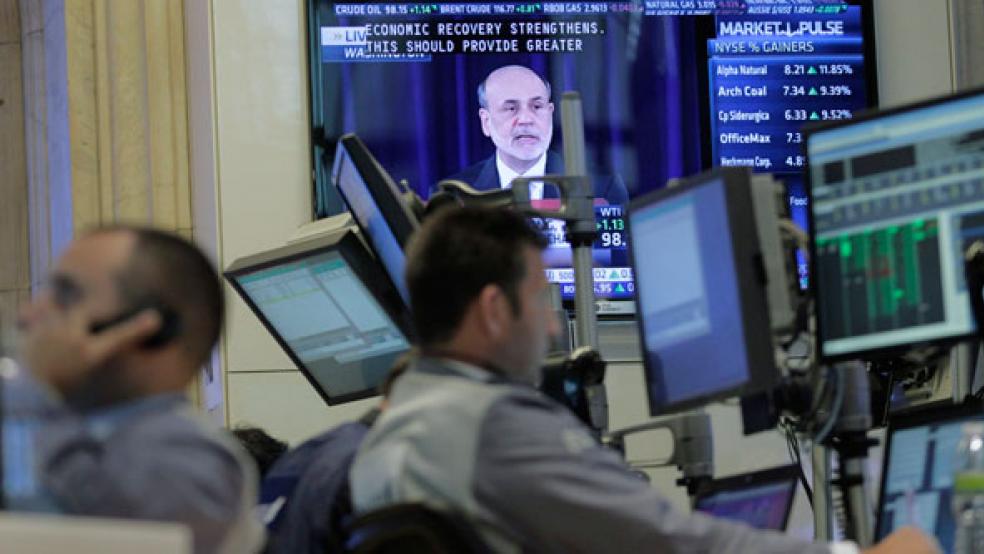Stocks fell on Tuesday, putting the S&P 500 on track for its second straight drop after comments from a pair of U.S. Federal Reserve officials left investors unsure about the timing of a possible reduction in its bond-buying program.
Dennis Lockhart, president of the Federal Reserve Bank of Atlanta, told Market News International in an interview that the Fed could begin trimming the size of the stimulus program as soon as September, but might wait longer if the expected economic growth in the year's second half fails to materialize.
RELATED: TRADERS WILL WATCH FED FOR SLIGHTEST TAPER TWEAK
 Later in the session, Chicago Fed President Charles Evans said the central bank will probably decrease its massive bond-buying stimulus program later this year, and depending on the economic data, could do so as early as next month.
Later in the session, Chicago Fed President Charles Evans said the central bank will probably decrease its massive bond-buying stimulus program later this year, and depending on the economic data, could do so as early as next month. Fed officials "are all hedging themselves, which is why the market continues to just be a little bit confused and why it is going to churn," said Ken Polcari, director of the NYSE floor division at O'Neil Securities in New York. "There is really no reason at the moment for the market to go higher because it is still too unclear."
One catalyst for Monday's downturn in the Dow and the S&P 500 was provided by Richard Fisher, president of the Federal Reserve Bank of Dallas. He said he supported scaling back the central bank's stimulus next month unless economic data takes a turn for the worse. The S&P 500 is on track for its biggest decline since June 24 as investors continue to take profits from the recent rally that lifted the Dow Jones industrial average and the S&P 500 to back-to-back record closing highs late last week.
The Dow Jones industrial average fell 90.03 points or 0.58 percent, to 15,522.10. The S&P 500 slipped 9.80 points or 0.57 percent, to 1,697.34. The Nasdaq Composite Index dropped 27.67 points or 0.75 percent to 3,665.29. Earlier, the Dow fell as low as 15,473.40, while the S&P 500 touched a session low of 1,693.29, and the Nasdaq hit an intraday low of 3,654.67.
The S&P 500 has risen for five of the past six weeks, gaining more than 7 percent over that period. The S&P 500's 50-day moving average now stands at 1,692.77, which could serve as a support level in any further market decline.
The market's swings were exaggerated by thin trading volume, which was light for the second consecutive day. Monday marked the lowest volume for a full-day session so far this year. With major U.S. economic data like the nonfarm payrolls report and earnings from bellwethers out of the way, volume is expected to be light throughout the week.
The biggest drag on the Dow was International Business Machines Corp (IBM.N), down 2.4 percent at $190.87, after Credit Suisse cut its rating on the stock to "underperform" from "neutral," saying organic growth would be challenging in the future. Credit Suisse also cut its price target on the Dow component by $25 to $175. IBM topped the list of the Dow's 10 worst-performing stocks.
Retailers' shares ranked among the day's biggest losers. American Eagle Outfitters (AEO.N) shares tumbled 13.7 percent to $17.24 a day after the retailer said its second-quarter profit would be hurt by weak sales and margins. A number of analysts downgraded the stock.
The stock hit a 52-week low of $16.60 and gave investors a reason to unload the shares of other retailers that cater to teens and young adults. Urban Outfitters (URBN.O) shares fell 2.9 percent to $42.41 and Aeropostale (ARO.N) slid 2.2 percent to $14.62. The S&P retail index slipped 0.4 percent. Cognizant Technology Solutions Corp (CTSH.O) shares gained 2.3 percent to $75.01 after the company reported a 20 percent rise in second-quarter revenue. Fossil Group Inc (FOSL.O) shares surged 17.3 percent to $126 after its results.
Of the 418 companies in the S&P 500 that have reported earnings for the second quarter through Tuesday, Thomson Reuters data showed that 67.5 percent have topped analysts' expectations, in line with the average beat over the past four quarters. On the revenue side, the data showed that 54 percent have reported revenue above estimates, more than in the past four quarters but below the historical average.
Shares of the Washington Post Co (WPO.N) climbed 4.3 percent to $592.95 after Amazon Inc (AMZN.O) founder Jeff Bezos agreed to buy the publishing company's newspaper assets for $250 million. Earlier, the stock touched a 52-week high at $605.
On the economic front, the U.S. trade deficit dropped in June to its lowest level in more than 3-1/2 years. Exports climbed to a record high and imports fell, suggesting an upward revision to the growth rate for second-quarter gross domestic product. The trade gap shrank to $34.2 billion, compared with economists' forecast that it would narrow to $43.5 billion.
This article is by Chuck Mikolajczak of Reuters.




